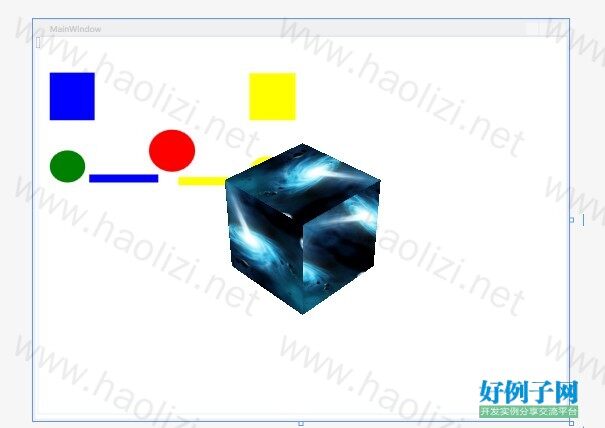实例介绍
【实例简介】使用OpenNI开发的人体姿势跟踪,通过跟踪人的右手动作,转动一个3D立方体。
需要下载安装 http://www.openni.org/wp-content/uploads/2013/07/OpenNI-Windows-x86-2.2.zip
【实例截图】

【核心代码】
using System;
using System.Collections.Generic;
using System.Threading;
using OpenNI;
namespace WpfNIFullBodyTracking
{
// Track one user who posed Psi, because the Draw the User is a hard work, so track one
// at first.
internal class UserTracker
{
#region Constructor
public UserTracker()
{
}
~UserTracker()
{
StopTracking();
}
#endregion
#region Properties
public Dictionary<int, UserInfo> Users
{
get { return userDict; }
}
#endregion
#region Public Methods
public bool Initialize()
{
try
{
context = Context.CreateFromXmlFile(ConfigurationFile, out scriptNode);
depthGenerator = (DepthGenerator)context.FindExistingNode(NodeType.Depth);
userGenerator = new UserGenerator(context);
}
catch (Exception)
{
return false;
}
skeletonCap = userGenerator.SkeletonCapability;
poseCap = userGenerator.PoseDetectionCapability;
userGenerator.NewUser = new EventHandler<NewUserEventArgs>(userGenerator_NewUser);
userGenerator.LostUser = new EventHandler<UserLostEventArgs>(userGenerator_LostUser);
skeletonCap.CalibrationStart = new EventHandler<CalibrationStartEventArgs>(SkeletonCapability_CalibrationStart);
skeletonCap.CalibrationComplete = new EventHandler<CalibrationProgressEventArgs>(SkeletonCapability_CalibrationComplete);
skeletonCap.SetSkeletonProfile(SkeletonProfile.Upper);
poseCap.PoseDetected = new EventHandler<PoseDetectedEventArgs>(poseCap_PoseDetected);
skeletonWorker = new Thread(SkeletonThreadFunc);
return true;
}
public void StartTracking()
{
if (!bRunning)
{
bRunning = true;
context.StartGeneratingAll();
skeletonWorker.Start();
}
}
public void StopTracking()
{
if (bRunning)
{
bRunning = false;
context.StopGeneratingAll();
skeletonWorker.Join();
context.Release();
}
}
#endregion
#region Event Handlers
void userGenerator_NewUser(object sender, NewUserEventArgs e)
{
UserInfo user = new UserInfo() { ID = e.ID };
userDict.Add(e.ID, user);
//userGenerator.SkeletonCapability.StartTracking(e.ID);
if(currentUser == -1)
poseCap.StartPoseDetection("Psi", e.ID);
}
void userGenerator_LostUser(object sender, UserLostEventArgs e)
{
if (userGenerator.SkeletonCapability.IsCalibrating(e.ID))
{
userGenerator.SkeletonCapability.AbortCalibration(e.ID);
}
userDict.Remove(e.ID);
if (currentUser == e.ID)
{
currentUser = -1;
}
}
void SkeletonCapability_CalibrationStart(object sender, CalibrationStartEventArgs e)
{
}
void SkeletonCapability_CalibrationComplete(object sender, CalibrationProgressEventArgs e)
{
if (e.Status == CalibrationStatus.OK)
{
skeletonCap.StartTracking(e.ID);
}
else
{
poseCap.StartPoseDetection("Psi", e.ID);
}
}
void poseCap_PoseDetected(object sender, PoseDetectedEventArgs e)
{
poseCap.StopPoseDetection(e.ID);
if (currentUser == -1)
{
currentUser = e.ID;
skeletonCap.RequestCalibration(e.ID, true);
}
}
#endregion
#region Private Helpers
private void SkeletonThreadFunc()
{
while (bRunning)
{
try
{
context.WaitAndUpdateAll();
}
catch (Exception)
{
}
int[] userIDs = userGenerator.GetUsers();
foreach (int i in userIDs)
{
if (skeletonCap.IsTracking(i) && i == currentUser)
{
UpdateUser(i);
}
}
}
}
private void UpdateUser(int i)
{
Point3D point = skeletonCap.GetSkeletonJointPosition(i, SkeletonJoint.Head).Position;
userDict[i].Head = depthGenerator.ConvertRealWorldToProjective(point);
point = skeletonCap.GetSkeletonJointPosition(i, SkeletonJoint.Neck).Position;
userDict[i].Neck = depthGenerator.ConvertRealWorldToProjective(point);
point = skeletonCap.GetSkeletonJointPosition(i, SkeletonJoint.LeftShoulder).Position;
userDict[i].LeftShoulder = depthGenerator.ConvertRealWorldToProjective(point);
point = skeletonCap.GetSkeletonJointPosition(i, SkeletonJoint.LeftElbow).Position;
userDict[i].LeftElbow = depthGenerator.ConvertRealWorldToProjective(point);
point = skeletonCap.GetSkeletonJointPosition(i, SkeletonJoint.LeftHand).Position;
userDict[i].LeftHand = depthGenerator.ConvertRealWorldToProjective(point);
point = skeletonCap.GetSkeletonJointPosition(i, SkeletonJoint.RightShoulder).Position;
userDict[i].RightShoulder = depthGenerator.ConvertRealWorldToProjective(point);
point = skeletonCap.GetSkeletonJointPosition(i, SkeletonJoint.RightElbow).Position;
userDict[i].RightElbow = depthGenerator.ConvertRealWorldToProjective(point);
point = skeletonCap.GetSkeletonJointPosition(i, SkeletonJoint.RightHand).Position;
userDict[i].RightHand = depthGenerator.ConvertRealWorldToProjective(point);
OnUpdateEvent(new UserUpdateEventArgs(userDict[i], UserState.Update));
}
#endregion
#region events
public event EventHandler<UserUpdateEventArgs> Update;
void OnUpdateEvent(UserUpdateEventArgs e)
{
if (Update != null)
{
Update.BeginInvoke(this, e, null, null);
}
}
#endregion
#region Fileds
private Dictionary<int, UserInfo> userDict = new Dictionary<int, UserInfo>();
private ScriptNode scriptNode = null;
private Context context = null;
private UserGenerator userGenerator = null;
private SkeletonCapability skeletonCap = null;
private DepthGenerator depthGenerator = null;
private bool bRunning = false;
private Thread skeletonWorker = null;
private const string ConfigurationFile = @"../../SamplesConfig.xml";
private PoseDetectionCapability poseCap = null;
private int currentUser = -1;
#endregion
}
}
标签:
小贴士
感谢您为本站写下的评论,您的评论对其它用户来说具有重要的参考价值,所以请认真填写。
- 类似“顶”、“沙发”之类没有营养的文字,对勤劳贡献的楼主来说是令人沮丧的反馈信息。
- 相信您也不想看到一排文字/表情墙,所以请不要反馈意义不大的重复字符,也请尽量不要纯表情的回复。
- 提问之前请再仔细看一遍楼主的说明,或许是您遗漏了。
- 请勿到处挖坑绊人、招贴广告。既占空间让人厌烦,又没人会搭理,于人于己都无利。
关于好例子网
本站旨在为广大IT学习爱好者提供一个非营利性互相学习交流分享平台。本站所有资源都可以被免费获取学习研究。本站资源来自网友分享,对搜索内容的合法性不具有预见性、识别性、控制性,仅供学习研究,请务必在下载后24小时内给予删除,不得用于其他任何用途,否则后果自负。基于互联网的特殊性,平台无法对用户传输的作品、信息、内容的权属或合法性、安全性、合规性、真实性、科学性、完整权、有效性等进行实质审查;无论平台是否已进行审查,用户均应自行承担因其传输的作品、信息、内容而可能或已经产生的侵权或权属纠纷等法律责任。本站所有资源不代表本站的观点或立场,基于网友分享,根据中国法律《信息网络传播权保护条例》第二十二与二十三条之规定,若资源存在侵权或相关问题请联系本站客服人员,点此联系我们。关于更多版权及免责申明参见 版权及免责申明



网友评论
我要评论